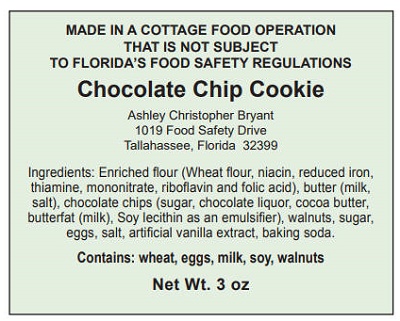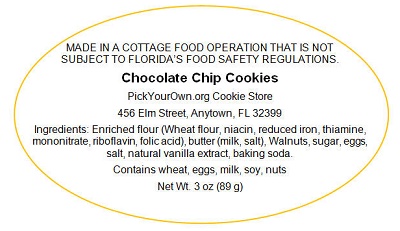
Looking for Florida Cottage Food Labeling Requirements in 2025? Scroll down this page and follow the links. And if you bring home some fruit or vegetables and want to can, freeze, make jam, salsa or pickles, see this page for simple, reliable, illustrated canning, freezing or preserving directions. There are plenty of other related resources, click on the resources dropdown above. If you are having a hard time finding canning lids, I've used these, and they're a great price & ship in 2 days.
If you have questions or feedback, please let me know! There are affiliate links on this page. Read our disclosure policy to learn more.
Florida Cottage Food Labeling Requirements
Florida Cottage Food Labeling Requirements
Cottage food products must be labeled in accordance with the requirements as outlined in Section 500.80(5), Florida Statutes, and United States Code of Federal Regulations Title 21, Part 101. A cottage food operation may only sell cottage food products which are prepackaged with a label attached that contains the following information (printed in English):
- The name and address of the cottage food operation; You must use the physical address of your home kitchen on your product label, not a post office box. The purpose of including an address on product labels is in case of a recall or traceback associated with a foodborne illness complaint or outbreak
- The name of the cottage food product;
- The ingredients of the cottage food product, in descending order of predominance by weight;
- The net weight or net volume of the cottage food product;
- Allergen information as specified by federal labeling requirements (see below).
- If any nutritional claim is made, appropriate nutritional information as specified by federal labeling requirements; and
- The following statement printed in at least 10-point type in a color that provides a clear contrast to the background label: "Made in a cottage food operation that is not subject to Florida's food safety regulations."
Allergens
- You must identify if any of your ingredients are made from
one of the following food groups: milk, eggs, wheat, peanuts,
soybeans, fish (including shellfish, crab, lobster or shrimp)
and tree nuts (such as almonds, pecans or walnuts). If you have
an ingredient made with a wheat based product, you can:
- Include the allergen in the ingredient list. For example, a white bread with the following ingredient listing: whole wheat flour, water, salt and yeast. In this example, the statement 'whole wheat flour', meets the requirements of federal law. OR
- Include an allergen statement ("Contains :") after the ingredient list. For example a white bread, with the following ingredients: whole wheat flour, water, sodium caseinate, salt and yeast. Contains wheat and milk. The "Contains" statement must reflect all the allergens found in the product. In this example, the sodium caseinate comes from milk.
- Nuts - If your cottage food has tree nuts as an ingredient you must identify which tree nut you are using. For example, if you made nut bread, an acceptable ingredient list would be: Ingredients: wheat flour, water, almonds, salt, yeast. The following would not be acceptable: Ingredients: flour, water, nuts, salt, yeast.
Date of the enactment of the Florida cottage food law: June 2011.
amended in May 2017
Sample label and Label Template
Click here for our template of labels in Microsoft Word format (most other editing programs can open it). It's free to download and use!
If the downloaded file doesn't open in Word, check your DOWNLOADS directory! the file will be there!
You can then edit it and print your own custom labels! You can order the blank label paper in the box at right.
Labeling Honey
Honey as defined by the Florida Standard of Identity for Honey (Rule: 5K-4.027) "means the natural food product resulting from the harvest of nectar by honey bees and the natural activities of the honey bees in processing nectar. It consists essentially of different sugars, predominately fructose and glucose as well as other substances such as organic acids, enzymes and solid particles derived from honey collection. The color of honey can vary from nearly colorless to dark brown. The consistency can be fluid, viscous or partially to completely crystallized. The flavor and aroma vary, but are derived from the plant's origin" (https://www.flrules.org/gateway/ruleNo.asp?id=5K-4.027).
- The name and address of the cottage food operation. The beekeeper must list his/her name on the label. No fictitious names are permitted under the cottage food operation legislation. Business names are acceptable.
- Full street address of the cottage food operation
-
The name of the product. The single word "honey" is acceptable.
-
The ingredients of the cottage food product, in descending order of predominance by weight. If honey contains any flavoring, spice or other added ingredient, then those additives must also appear on the label; for example, "lime essence honey." See Florida Department of Agriculture and Consumer Services Rule 5K-4.027 (4) Standard Identity for Honey (https://www.flrules.org/gateway/ruleno.asp?id=5K-4.027).
-
The net weight or net volume of the cottage food product. The contents of the product should be expressed in net weight or net volume. The statement must be displayed in the bottom 30% of the label. The words "net weight" may be abbreviated to "Net.Wt."
-
Allergen information as specified by federal labeling requirements. The Food Allergen Labeling and Consumer Protection Act requires food labels to identify in plain English if the product contains any of the eight major food allergens; milk, eggs, fish, crustacean shellfish, peanuts, tree nuts, wheat, and soybeans. The Act does not include honey, and honey is not listed as an allergen. However, honey has been associated with infant botulism and as such is considered a dietary risk for infants less than one year of age. It is recommended beekeepers display on their labels, "Do not feed to infants less than one year old." See the following document for more information: http://edis.ifas.ufl.edu/aa142.
-
The following statement must be in at least 10-point type in a color that provides a clear contrast to the background of the label: "Made in a cottage food operation that is not subject to Florida's food safety regulations."
More resources:
-
Florida Division of Food Safety Fact Sheet
Click here for more information about this state's cottage food requirements . - Florida 2017 amended cottage food laws
- Florida Cottage Food Law Updates Facebook page
Questions? Contact Information:
Looking for canning equipment and supplies?
Water bath canner with a jar rack
Pressure canners for gas, electric and induction stoves: Presto 23Qt or T-fal 22Qt
Canning scoop (this one is PERFECT)
Ball Blue book (most recent version)
Jars: 8oz canning jars for jams
Find Other types of farms:
Farm markets and roadside stands
Road trips and camping resources
Local Honey, apiaries, beekeepers
Consumer fraud and scams information
Home canning supplies at the best prices on the internet!
Maple Syrup Farms, sugarworks, maple syrup festivals
Environmental information and resources
Farms For Your Event for birthday parties, weddings, receptions, business meetings, retreats, etc.
Festivals - local fruit and vegetable festivals
Get the
most recent version of
the Ball Blue Book
With this Presto 23 quart pressure canner and pressure cooker, you can "can" everything, fruits, vegetables, jams, jellies, salsa, applesauce, pickles, even meats, soups, stews. Model 01781

You can make jams, jellies, can fruit, applesauce, salsa and pickles with water bath canners, like this Granite Ware 12-Piece Canner Kit, Jar Rack, Blancher, Colander and 5 piece Canning Tool Set

